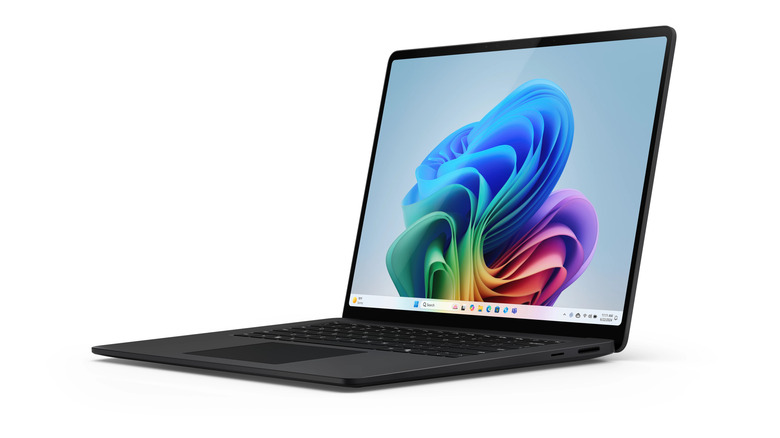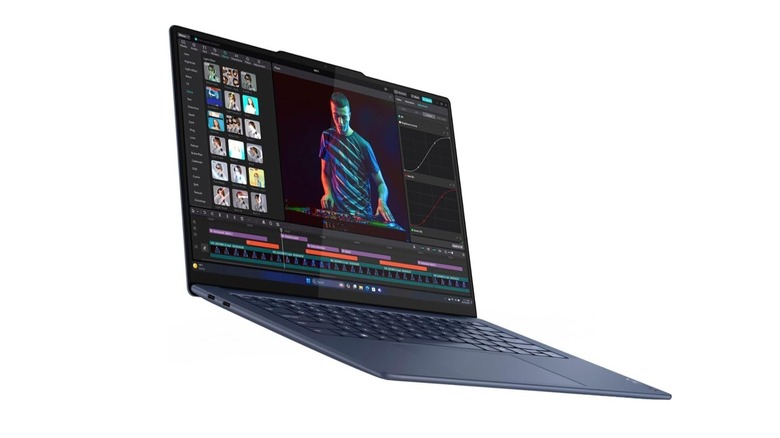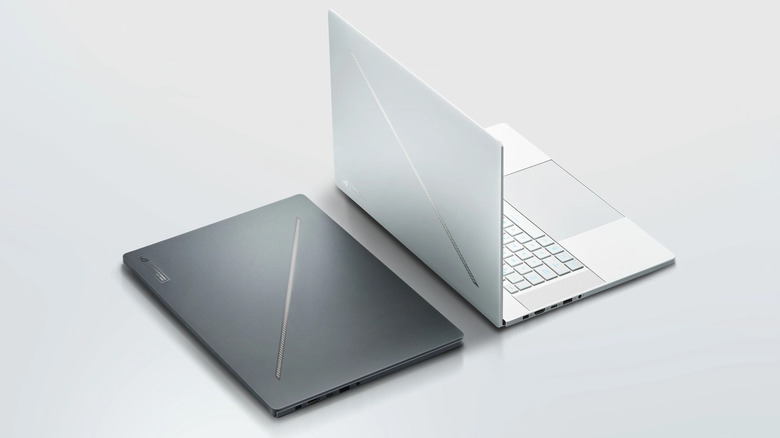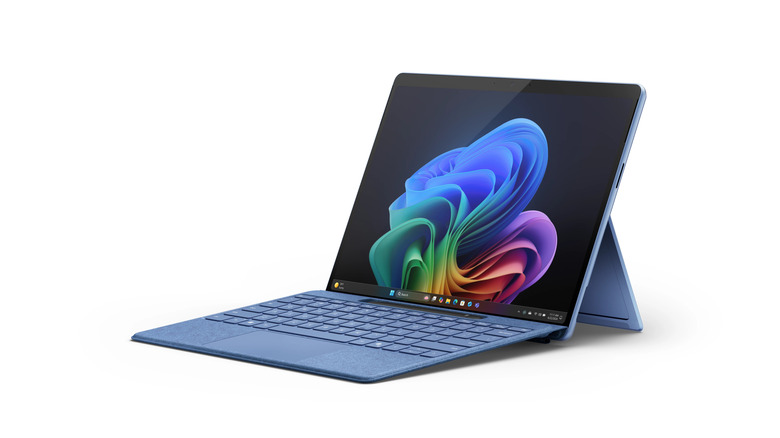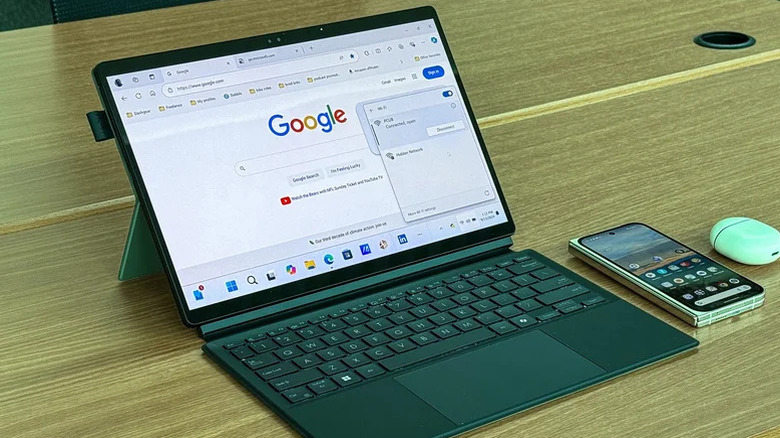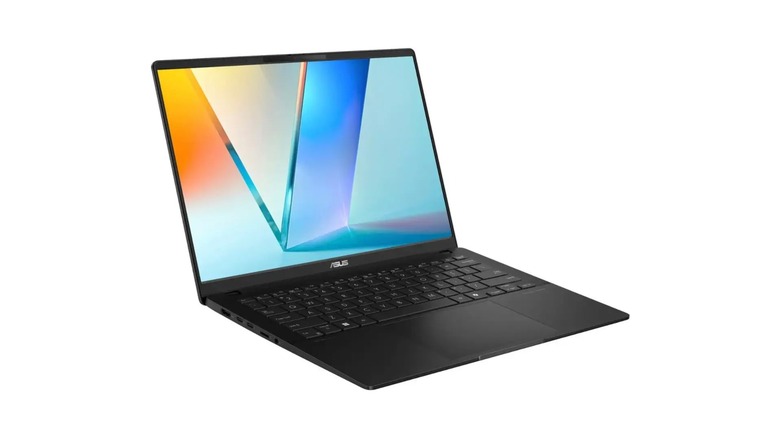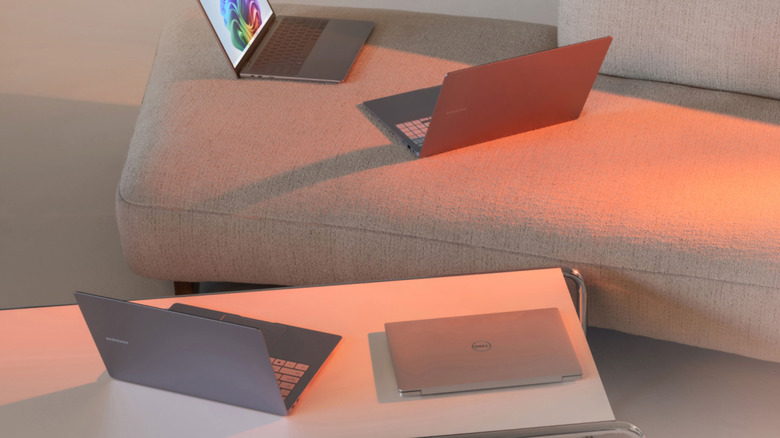6 Of The Best Microsoft CoPilot+ Laptops You Can Buy
We may receive a commission on purchases made from links.
The era of AI computing is fully upon us, at least for the time being, and Microsoft has pivoted to meet the moment with a new designation of Windows computers. They're called Copilot+ PCs, named after the AI tool now available on Windows 11. But artificial intelligence is one of the least notable aspects of these machines. What makes them great laptops isn't the Copilot button built into their keyboards, but their brand new processors, some of which are the first of their kind. These laptops are already disrupting the product category and quickly proving to include some of the best devices you can buy as we head into 2025.
If you've been shopping around for a Copilot+ PC, you might find your eyes glazing over as you stare at spec sheets, reviews, and other data points. That's why I've done all of that for you to try and narrow down some of the best devices in this new category of laptops. As one of SlashGear's resident PC and Windows experts, I've spent a lot of time down in the weeds, combing through these laptops, reading reviews, and applying what I know about computers. I've also had the opportunity to spend some time with a few Copilot+ PCs, giving me the opportunity to evaluate the new ARM-based Snapdragon X chips on my own terms.
So, with a slew of these sleek, AI-forward devices now on the market, which ones are worth your attention the next time you go shopping for a new laptop? Here are six of the best Copilot+ PCs you can buy.
What is a Copilot PC laptop?
To oversimplify everything about Microsoft Copilot+ PCs, they're Windows 11 computers with processors that have neural processing units (NPUs), which are specific portions of the CPU that handle AI tasks. Specific experiences, such as the controversial Recall feature, will be available specifically on these laptops. At the time of this writing, though, you shouldn't buy a Copilot+ PC for its exclusive features, as what's on offer is quite paltry. There's some photo generation stuff of the kind you could get online for free, a live caption feature, and some camera enhancements.
Microsoft kicked off the new category by partnering with Qualcomm to deliver the first Windows laptops powered by ARM chips. These laptops, which use Qualcomm's Snapdragon X Elite and X Plus CPUs, directly compete with Apple's M series silicon, which is also ARM based. Since ARM is much more efficient than a traditional x86 processor of the kind you'd find in other Windows computers, these laptops can often have better battery life and excellent performance in optimized apps.
One common misconception is the idea that all Copilot+ PCs are ARM devices. However, there are now x86-based Copilot+ PCs for those who don't yet want to make the leap to ARM. Both AMD and Intel have released new CPUs that are now available in some of the latest models. ARM processors are likely going to keep gaining market share and popularity in the PC market, but for now, many Windows programs are not optimized for them. If you're a gamer or a professional who needs specialized apps, you should check to see if the tools you need have ARM versions before getting a Snapdragon laptop.
Best for most people: Microsoft Surface Laptop 7th Edition
For over a decade, Microsoft has been making its own line of Windows devices under the Surface banner. The Surface Laptop is the most conventional of these, with a standard clamshell design. It is essentially Microsoft's answer to the MacBook Pro. This year, the 7th Edition of the Surface Laptop ditched x86 architecture in favor of Qualcomm's Snapdragon X processors. The result is a powerful laptop with a long battery life in a sleek package.
Starting at just under $1,000, the Surface Laptop 7th Edition can be configured in 13.8 or 15-inch variants, with either a Qualcomm Snapdragon X Elite or X Plus. Both are very capable processors, with the X Elite being most powerful. It can be configured with 16, 32, or 64 GB of RAM and either 512 GB or 1 TB of storage. On ARM devices, RAM cannot be replaced or upgraded, so at least 32 GB is the most future-proof way to go. As for I/O, you'll get two USB Type-C USB4 ports with Power Delivery, Thunderbolt 4, and DisplayPort. There's also a single Type-A port with USB 3.1, a 3.5mm headphone jack, and a Surface connect port, which is a proprietary connection for certain accessories.
Reviewers have formed a positive consensus around this laptop. Multiple outlets praised it for its excellent battery life, including RTINGS, WIRED, TechRadar, and Engadget. Most reviews also noted its high quality design, great keyboard and haptic trackpad, and speedy performance in optimized apps. However, some were miffed by the lack of an OLED display option, which is reserved for the tablet-style Surface Pro and the far more expensive Surface Studio. If you're looking for a Copilot+ PC, think of this laptop as the platonic ideal.
Best for students: Lenovo Yoga Slim 7x
Lenovo wasn't being hyperbolic when it named the Yoga Slim 7x, which is just over half an inch thick. In fact, it's so slim that the USB-C ports are curved around the side of the chassis. It's a design that's likely possible due to the ARM processor inside, which highlights one of the major advantages of ARM over x86 processors. It's the same reason Apple was able to make the latest iPad Pro so thin. If you want a laptop that fits into a crowded backpack, this is the Copilot+ PC to consider.
At $1,199 MSRP (but often on sale for far less), the Yoga Slim 7x packs a Qualcomm Snapdragon X Elite processor, which should translate into fantastic performance with ARM-optimized apps. On top of that, it's got a 2944x1840 OLED display that runs at 90 Hz and is certified for Dolby Vision, meaning an excellent image whether you're editing photos in Lightroom or just kicking back to watch Netflix. For I/O, you're looking at three USB Type-C USB4 ports with Power Delivery and DisplayPort, which is pretty great for a device in this weight class. There's also a webcam kill switch on the side. However, there's no headphone jack here, which is disappointing.
Reviewers have mostly liked this laptop, earning it a place on this list. It was praised by PC Mag, WIRED, and Tom's Guide for its battery life, although Gizmodo found the battery disappointing. What all of these reviews agreed on, though, is that the display is gorgeous. Predictably, all were irritated by the lack of a headphone jack, though that may not be a dealbreaker for some. This is a great laptop for students or office workers.
Best for gamers: ASUS ROG Zephyrus G16
If you're shopping for a gaming laptop, you should avoid Snapdragon-powered laptops on this list. Luckily, Copilot+ PCs are also now shipping with the latest AMD and Intel chips. One such machine is the ASUS ROG Zephyrus G16, the latest in a line of well-reviewed gaming laptops. I've enjoyed ROG Zephyrus laptops for years, as have others in my life. Their combination of sleek designs with powerful hardware and surprisingly great performance for their size is hard to beat. The 2024 version of the G16 appears to be continuing that trend.
You can get the 2024 ROG Zephyrus G16 powered by either an Intel Core Ultra 9 185H or an AMD Ryzen AI 9 HX 370 processor. There 32 GB of speedy LPDDR5X RAM, and 1 TB of PCIe Gen 4 SSD storage. Depending on how you configure it, you're can get anywhere from an Nvidia GeForce RTX 4060 all the way up to a 4090 laptop GPU. As for the display, it's a 16-inch OLED panel with a staggering 240 Hz refresh rate, so if you miss a shot in "Marvel Rivals," you know it's a skill issue. With many configurations to choose from, there's a lot of room to play around. If you need some guidance or inspiration, check out our guide on how to choose the right gaming laptop for you.
In SlashGear's review of the 2024 ROG Zephyrus G16, we gave it an eight out of ten rating and awarded it our SlashGear select badge. Our reviewer, the brilliant Nadeem Sarwar, praised its incredible design, gorgeous screen, massive trackpad, and power. However, he was less than thrilled that its performance is hampered by low wattage, poor thermals, and non-upgradable memory.
Best alternative form factor: Microsoft Surface Pro 11
For well over a decade, the Microsoft Surface has iterated on a tablet form factor with a built-in kickstand and detachable keyboard. If you're looking for a Copilot+ PC that ditches a traditional clamshell laptop design in favor of something a little different, the Surface Pro 11 could be just right. Thanks to the Snapdragon X chip, this is the first year Microsoft has actually delivered all the benefits of a tablet and Windows laptop in one device.
The downside is the price. It starts at just shy of $1,000 for the most basic configuration with a Snapdragon X Plus, 16 GB of RAM, 256 GB SSD, and an LCD panel. But if you bump the specs up to their top-end configuration with a Snapdragon X Elite, 32 GB of RAM, 1 TB of SSD storage, and an OLED display, you'll be looking at about $2,100. The keyboard, sold separately, will run you another $180, and a stylus will add a further $100, bringing the total up to about $2,380. If you can stomach that price (and the switch to ARM), though, the Surface Pro is by most accounts pretty fantastic.
It got an 8.3 from CNET, a 7 from The Verge, an average of 7.8 from RTINGS, and four out of five stars from Tom's Guide. Reviews highlight its long-lasting battery life, fantastic OLED display, and great performance in ARM-optimized apps. One amazing feature worth noting is the fully swappable SSD, a rarity for ARM devices. Beware of the limited port selection, however. As a tablet first and foremost, the Surface Pro comes with two USB-C ports and Microsoft's Surface Connect port.
A cheaper Surface Pro alternative: ASUS ProArt PZ13
If you love the idea of a Windows 11 tablet with a detachable keyboard but can't stomach the price of the Microsoft Surface Pro (listed above), then you might find your dream Copilot+ PC in the ASUS ProArt PZ13. This sleek little slate will leave you about $1,100 poorer, but that's not nearly as unreasonable as Microsoft's tablet PC. There are even some aspects of the ProArt PZ13 that are even better than the Surface. It's powered by the Snapdragon X Plus and has 16 GB of LPDDR5x RAM, which are the same specs as the base model of the Surface Pro.
While the base Surface eschews a superior OLED display in favor of a cheaper LCD, the PZ13 has those sweet OLED pixels by default, and at a very similar resolution. It also has a full terabyte of storage compared to half that on the base Surface Pro. Moreover, the PZ13 includes its keyboard in the box and differentiates itself further by having a detachable, magnetic backplate, and by including an SD reader and USB 4.0 ports.
In SlashGear's review of the ASUS ProArt PZ13, Adam Doud rated it a seven out of ten, highlighting it's OLED display, fun form factor, and incredible battery life. WIRED found it lacking in performance compared to the Surface but raved about its incredible battery life and value proposition in a six out of ten review. PCMag, on the other hand, gave it a four out of five due to its value and OLED display, while Tom's Guide also awarded a four out of five for design, battery life, and value, while also highlighting the Snapdragon X Plus.
Best for a tight budget: ASUS Vivobook S 14
Because they're based on the latest processors from Qualcomm, Intel, and AMD, Microsoft Copilot+ PCs tend to be expensive. However, one notebook bucks that trend. The ASUS Vivobook S 14 comes in at $900 on Amazon. That's a solid price for this laptop, which packs an Intel Core Ultra 5 processor, 16 GB of speedy LPDDR5X RAM, and a 512 GB NVMe SSD storage unit. The processor is midrange, but the rest of those specs are quite timely. But the real value add is a 14-inch AMOLED display at an FHD resolution of 1920 x 1200 — quite the rarity for a clamshell below the $1,000 mark.
The Vivobook S 14 isn't skimping on I/O, either. It comes with two Thunderbolt 4 USB-C ports, an HDMI 2.1 port, two USB-A ports with USB 3.2, a headphone/microphone jack, and a Micro SD card reader. It's a decently slim package, too, with a thickness of 0.85 inches. Altogether, this combination of specs makes it a great laptop for students, remote workers on a budget, or anyone who doesn't use graphics-heavy apps and games.
Reviewers love how much value the Vivobook S 14 brings to the table. PCWorld gave it four out of five stars, WIRED an eight out of 10, and Tom's Guide three-and-a-half stars out of five. All of these reviewers praised the screen, the battery life, and the price. While some praised the performance, take that with a grain of salt for this Core Ultra 5 model, as reviewers seemed to be using the Core Ultra 7 or even 9 on some of their units, which have slightly higher price tags.
How these Copilot PCs were selected
Each of the laptops recommended in this article was selected based on a careful review of its spec sheet, reviews from trusted outlets, and my personal expertise regarding consumer electronics and the PC market. Customer reviews were also considered, with care taken to exclude those which may not have been genuine. In some cases, our experts went hands-on with the product for a full review.


